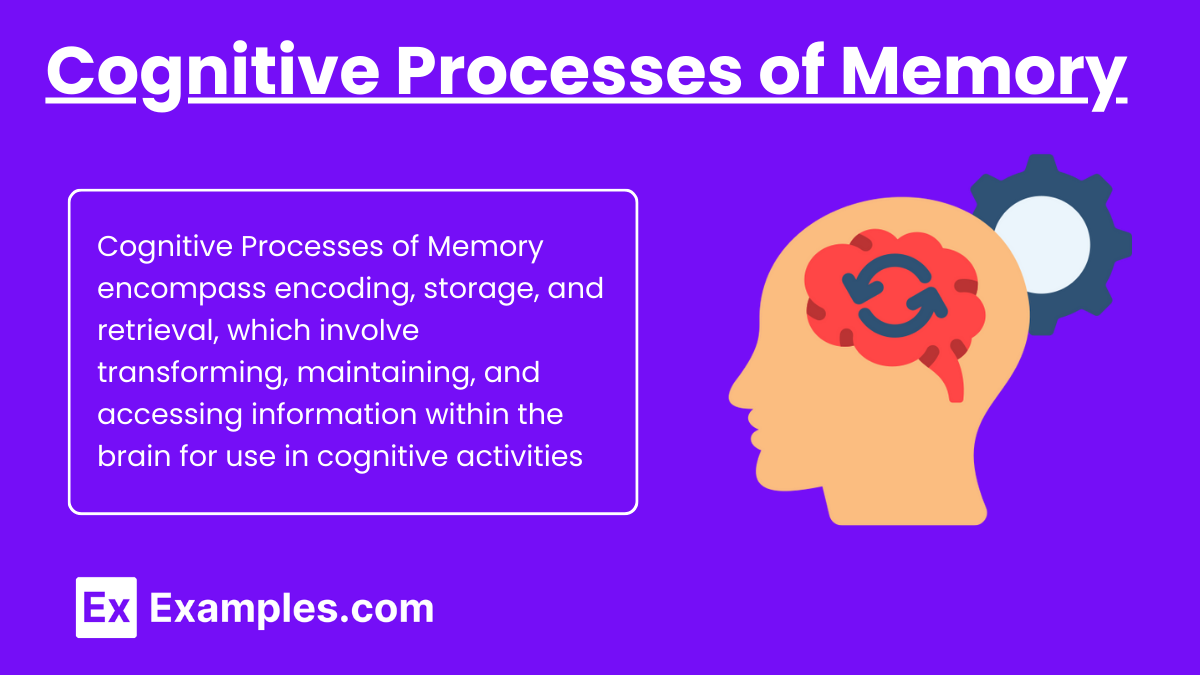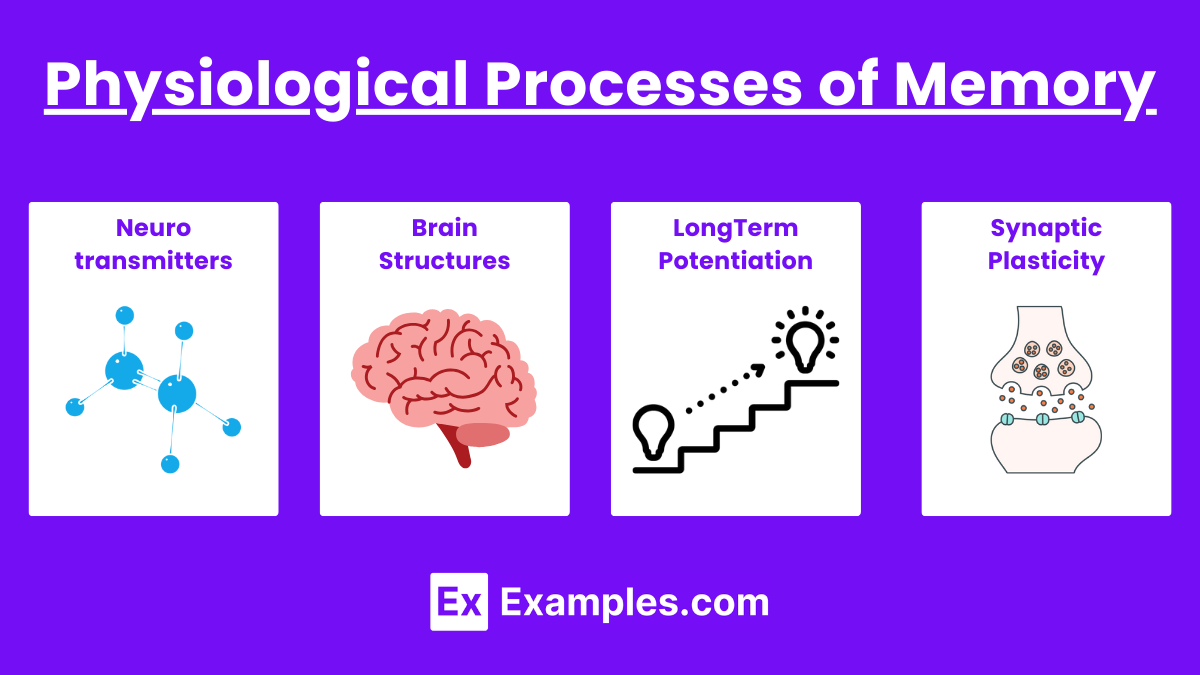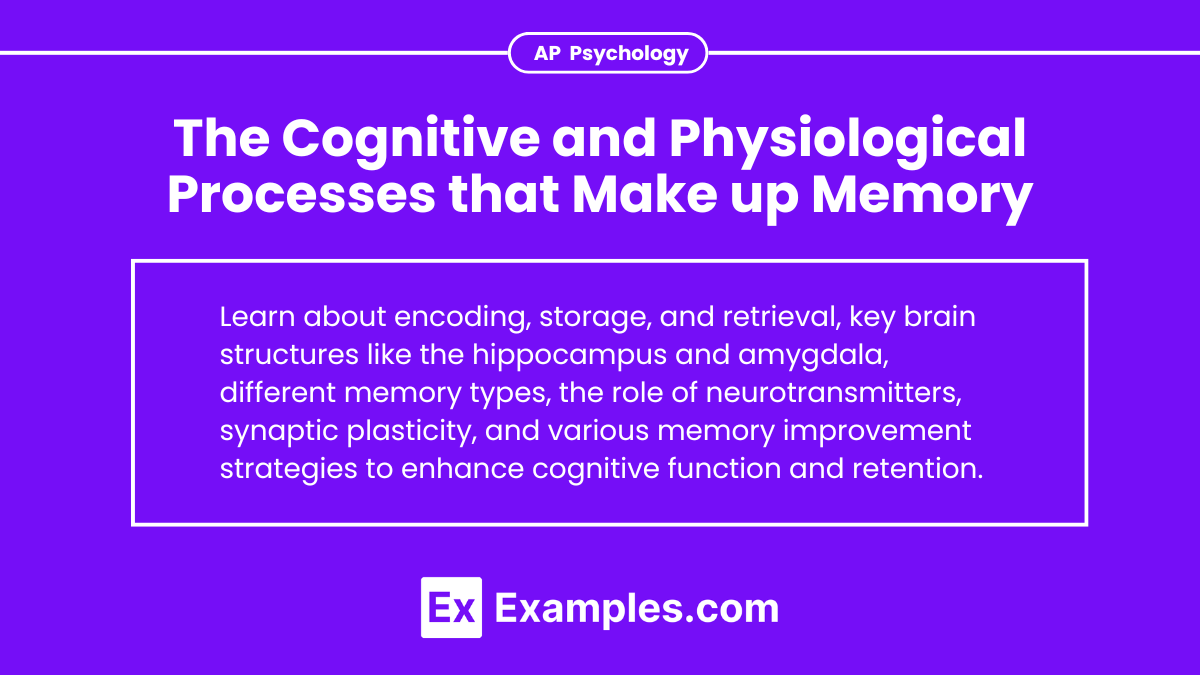Memory involves complex cognitive and physiological processes essential for learning and behavior. In AP Psychology, understanding these processes is crucial. Cognitively, memory includes encoding, storage, and retrieval of information. Physiologically, it involves brain structures like the hippocampus, amygdala, and prefrontal cortex, which are vital for memory formation, consolidation, and retrieval. Different types of memory, such as sensory, short-term, and long-term memory, interact to store and recall information, enabling complex thought and actions.
Learning Objectives
You will understand the cognitive processes involved in memory, including encoding, storage, and retrieval. Learn about physiological processes such as the role of the hippocampus, amygdala, and other brain structures in memory formation and consolidation. Explore different types of memory (short-term, long-term, sensory, and working memory) and how they function. Gain insight into memory disorders and the impact of neuroplasticity. Develop skills to apply this knowledge to real-world scenarios and psychological practice.
1. Cognitive Processes of Memory

1. Encoding
Encoding is the process of converting sensory input into a form that can be stored in memory. This involves transforming visual, auditory, and other sensory information into meaningful representations.
Types of Encoding
1. Visual Encoding
Visual encoding involves converting visual images into a mental representation. This type of encoding is essential for storing information about objects, scenes, and spatial arrangements.
- Examples:
- Remembering a friend’s face.
- Visualizing a map of your route to school.
2. Acoustic Encoding
Acoustic encoding is the process of encoding sounds, particularly the sounds of words. This form of encoding is crucial for language comprehension and verbal memory.
- Examples:
- Recalling a song’s melody.
- Remembering a phone number by repeating it aloud.
3. Semantic Encoding
Semantic encoding involves encoding the meaning of words and concepts. It is the most effective form of encoding because it allows for deeper processing and better recall.
- Examples:
- Understanding and remembering the plot of a story.
- Grasping the concepts of a scientific theory.
Processes Involved in Encoding
1. Attention
Attention is the first crucial step in the encoding process. It determines what information is transferred from sensory memory to short-term memory. Focused attention ensures that relevant information is encoded effectively.
- Selective Attention: Concentrating on specific stimuli while ignoring others.
- Divided Attention: Splitting focus between multiple tasks, which can impair encoding quality.
2. Elaborative Rehearsal
Elaborative rehearsal is the process of linking new information to existing knowledge. This deepens the encoding process and enhances memory retention.
- Examples:
- Creating associations between new vocabulary words and familiar concepts.
- Using analogies to understand complex ideas.
3. Organizational Encoding
Organizational encoding involves categorizing information based on relationships among items. This method helps in structuring information in a way that makes it easier to retrieve later.
- Examples:
- Grouping grocery items by category (fruits, vegetables, dairy).
- Organizing notes by topic and subtopic.
Factors Affecting Encoding
1. Depth of Processing
According to the Levels of Processing Theory, deeper processing leads to better encoding. Shallow processing, such as focusing on the physical features of information, results in weaker memories.
- Shallow Processing: Noting the font of a word.
- Deep Processing: Understanding the meaning and implications of a word.
2. Encoding Specificity Principle
This principle states that memory is improved when information available at encoding is also available at retrieval. Contextual cues and state-dependent memory are examples of this principle.
- Contextual Cues: Studying in the same environment where you will take the test.
- State-Dependent Memory: Recalling information better when in the same emotional or physiological state as when it was encoded.
3. Mnemonics
Mnemonics are memory aids that facilitate encoding by using vivid imagery, rhymes, or acronyms.
- Examples:
- Using “HOMES” to remember the Great Lakes (Huron, Ontario, Michigan, Erie, Superior).
- Creating a vivid mental image to recall a list of items.
Role of the Brain in Encoding
- Hippocampus : The hippocampus is crucial for converting short-term memories into long-term memories. It is involved in the formation of explicit memories (facts and events).
- Prefrontal Cortex : The prefrontal cortex is associated with working memory and executive functions, such as planning and decision-making, which are essential for effective encoding.
- Amygdala : The amygdala processes emotional memories, enhancing the encoding of events with emotional significance.
2. Storage

Storage refers to maintaining encoded information over time. This process involves different types of memory storage systems:
Storage: Preserving Information in Memory
Storage is the second fundamental process in memory, following encoding. It involves maintaining encoded information over time so that it can be retrieved when needed. The storage process encompasses various types and stages of memory, each with its distinct characteristics and functions.
Types of Memory Storage
1. Sensory Memory
Sensory memory holds sensory information for a very brief period, usually less than a second. It acts as a buffer for stimuli received through the senses.
- Iconic Memory: Visual sensory memory lasting about 0.3 seconds.
- Echoic Memory: Auditory sensory memory lasting about 3-4 seconds.
Example: Quickly glancing at a scene and briefly retaining its visual details.
2. Short-Term Memory (STM)
Short-term memory, also known as working memory, temporarily holds a limited amount of information for a short duration, typically around 20-30 seconds. It has a limited capacity, often described as 7±2 items.
- Example: Remembering a phone number long enough to dial it.
3. Long-Term Memory (LTM)
Long-term memory stores information for extended periods, ranging from hours to a lifetime. It has a virtually unlimited capacity and is divided into several subtypes:
Explicit (Declarative) Memory
Explicit memory involves conscious recollection of facts and events.
- Semantic Memory: Stores general knowledge and facts.
- Example: Knowing the capital of France is Paris.
- Episodic Memory: Stores personal experiences and events.
- Example: Remembering your last birthday party.
Implicit (Non-Declarative) Memory
Implicit memory involves skills and procedures performed without conscious awareness.
- Procedural Memory: Stores motor skills and actions.
- Example: Riding a bicycle or playing a musical instrument.
- Classical Conditioning: Stores learned associations.
- Example: Salivating when smelling food due to past conditioning.
Processes Involved in Memory Storage
1. Consolidation
Consolidation is the process by which short-term memories are transformed into long-term memories. This process involves the stabilization and strengthening of memory traces and can occur over a period ranging from hours to years.
- Example: Studying and reviewing material over time to ensure it is stored in long-term memory.
2. Synaptic Plasticity
Synaptic plasticity refers to the changes in the strength and efficiency of synaptic connections between neurons. Long-Term Potentiation (LTP) is a key mechanism underlying synaptic plasticity and memory storage.
- Example: Repeated practice of a skill leading to stronger synaptic connections in the brain areas involved.
3. Brain Structures Involved in Storage
- Hippocampus: Essential for forming new explicit memories and transferring them to long-term storage.
- Cerebral Cortex: Involved in storing long-term memories, particularly semantic and episodic memories.
- Cerebellum: Important for procedural memories and motor skills.
- Amygdala: Stores emotional memories and enhances the consolidation of emotionally significant events.
Factors Affecting Memory Storage
1. Rehearsal and Repetition
Regular rehearsal and repetition of information enhance its consolidation and storage in long-term memory.
- Example: Practicing vocabulary words repeatedly to store them in long-term memory.
2. Sleep
Sleep plays a crucial role in memory consolidation. During sleep, the brain processes and consolidates information from the day, transferring it to long-term storage.
- Example: Getting adequate sleep after studying to improve memory retention.
3. Emotional Arousal
Emotionally charged events are often better remembered due to the involvement of the amygdala in enhancing the consolidation process.
- Example: Clearly remembering a significant emotional event, such as a graduation or a traumatic incident.
4. Depth of Processing
The depth at which information is processed during encoding affects its storage. Deeper, more meaningful processing leads to better storage and retrieval.
- Example: Understanding and relating new information to existing knowledge rather than just memorizing facts.
Strategies to Enhance Memory Storage
1. Elaborative Rehearsal
Elaborative rehearsal involves linking new information to existing knowledge and creating meaningful associations.
- Example: Creating mind maps to connect related concepts.
2. Mnemonic Devices
Mnemonics help encode and store information by using vivid imagery, acronyms, or rhymes.
- Example: Using the acronym “ROYGBIV” to remember the colors of the rainbow.
3. Chunking
Chunking involves grouping individual pieces of information into larger, meaningful units, making it easier to store and recall.
- Example: Grouping digits of a phone number into chunks (e.g., 555-123-4567).
4. Distributed Practice
Spaced repetition, or distributed practice, involves spreading out study sessions over time, which enhances long-term memory storage.
- Example: Studying a little bit each day over several weeks rather than cramming the night before an exam.
3. Retrieval

Retrieval is the process of accessing and bringing stored information from memory into conscious awareness. It is the final step in the memory process, following encoding and storage. Effective retrieval is essential for utilizing the information stored in memory, whether for academic purposes, everyday tasks, or other activities.
Types of Retrieval
1. Recall
Recall involves retrieving information without the presence of cues. It requires the generation of information purely from memory.
- Example: Writing an essay exam where you must remember and explain concepts without prompts.
2. Recognition
Recognition involves identifying previously learned information with the help of cues. It is generally easier than recall because the presence of cues aids memory retrieval.
- Example: Answering multiple-choice questions on an exam.
3. Relearning
Relearning measures how quickly previously learned information can be reacquired. It is a way to assess memory retention over time.
- Example: Reviewing a language you studied in the past and finding it easier to pick up again.
Processes Involved in Retrieval
1. Retrieval Cues
Retrieval cues are stimuli that help bring stored information to mind. These cues can be external (environmental) or internal (thoughts, emotions).
- External Cues: Environmental factors such as sights, sounds, or smells.
- Example: Smelling a particular perfume that reminds you of a person.
- Internal Cues: Thoughts or emotions that trigger memory retrieval.
- Example: Feeling anxious about an exam and remembering study tips.
2. Encoding Specificity Principle
The encoding specificity principle states that memory is most effective when the conditions at retrieval match those at encoding. Context-dependent and state-dependent memory are examples of this principle.
- Context-Dependent Memory: Better recall of information in the same environment where it was learned.
- Example: Taking a test in the same classroom where you studied.
- State-Dependent Memory: Better recall of information when in the same physical or emotional state as when it was encoded.
- Example: Recalling information learned while happy when you are happy again.
3. Priming
Priming involves the activation of certain associations in memory, often unconsciously, which can influence retrieval.
- Example: Seeing the word “yellow” may make it easier to recognize the word “banana.”
Factors Affecting Retrieval
1. Interference
Interference occurs when other information disrupts the retrieval of a particular memory. There are two types of interference:
- Proactive Interference: Older information hinders the retrieval of newer information.
- Example: Difficulty remembering a new phone number because of the old one.
- Retroactive Interference: Newer information hinders the retrieval of older information.
- Example: Forgetting the old address because of the new one.
2. Decay Theory
Decay theory suggests that memories fade over time if they are not accessed regularly. The strength of a memory trace weakens, making retrieval more difficult.
- Example: Forgetting a foreign language over time if it is not practiced.
3. Retrieval Failure
Retrieval failure occurs when information is stored in memory but cannot be accessed at the moment. This can happen due to a lack of retrieval cues or interference.
- Example: Being unable to recall a fact during an exam but remembering it later.
Strategies to Enhance Retrieval
1. Use of Mnemonics
Mnemonics are memory aids that enhance retrieval by associating new information with familiar concepts or vivid imagery.
- Example: Using the acronym “PEMDAS” to remember the order of operations in math (Parentheses, Exponents, Multiplication and Division, Addition and Subtraction).
2. Practice Retrieval
Practicing retrieval, also known as the testing effect, involves actively recalling information rather than just reviewing it. This strengthens memory and enhances long-term retention.
- Example: Using flashcards to test your knowledge on a subject.
3. Distributed Practice
Spaced repetition involves spreading out study sessions over time, which improves memory retrieval compared to massed practice (cramming).
- Example: Studying a little bit each day for a week rather than all at once the night before an exam.
4. Elaborative Rehearsal
Elaborative rehearsal involves deeply processing information by making meaningful connections to existing knowledge, which enhances retrieval.
- Example: Relating new psychological concepts to personal experiences or familiar examples.
5. Contextual and State Cues
Studying in environments similar to the testing environment and maintaining a consistent physical or emotional state can enhance retrieval.
- Example: Practicing relaxation techniques if you study in a calm state and want to recall information in a stressful exam setting.
Physiological Processes of Memory

1. Neurotransmitters
Neurotransmitters play a key role in the formation and retrieval of memories. Some important neurotransmitters involved in memory processes include:
- Acetylcholine: Essential for encoding new memories and recalling old ones.
- Glutamate: Involved in synaptic plasticity and long-term potentiation (LTP), crucial for learning and memory.
- Dopamine: Affects attention and the reinforcement of memories.
2. Brain Structures
Different brain regions are involved in various aspects of memory processing:
- Hippocampus: Critical for the formation of new explicit memories and transferring them to long-term storage.
- Amygdala: Involved in emotional memories, particularly fear-related memories.
- Cerebellum: Important for procedural memories and motor skills.
- Prefrontal Cortex: Associated with working memory and executive functions.
3. Long-Term Potentiation (LTP)
LTP is a long-lasting enhancement in signal transmission between two neurons that results from their synchronous activation. It is considered a primary cellular mechanism that underlies learning and memory.
4. Synaptic Plasticity
Synaptic plasticity refers to the ability of synapses to strengthen or weaken over time, in response to increases or decreases in their activity. This plasticity is crucial for learning and memory formation.
Memory Models
1. Atkinson-Shiffrin Model
This model proposes three stages of memory:
- Sensory Memory: Briefly holds sensory information.
- Short-Term Memory: Holds a small amount of information for a short period.
- Long-Term Memory: Stores information for extended periods.
2. Baddeley’s Working Memory Model
This model describes working memory as a system with multiple components:
- Central Executive: Directs attention and coordinates activities.
- Phonological Loop: Handles auditory and verbal information.
- Visuospatial Sketchpad: Manages visual and spatial information.
- Episodic Buffer: Integrates information from different sources into a single, coherent episode.
3. Levels of Processing Theory
This theory suggests that memory retention depends on the depth of processing. Deeper, more meaningful processing leads to better memory retention.
- Shallow Processing: Involves surface-level features such as the appearance of words.
- Deep Processing: Involves semantic processing and understanding the meaning of the information.
Memory Improvement Strategies
- Chunking : Grouping information into meaningful units to enhance short-term memory capacity.
- Mnemonics : Using acronyms, visual imagery, or rhymes to aid memory recall.
- Elaborative Rehearsal : Connecting new information with existing knowledge to facilitate deeper processing.
- Distributed Practice : Spacing out study sessions over time to enhance long-term retention.
- Retrieval Practice : Testing oneself on the material to improve memory and understanding.


